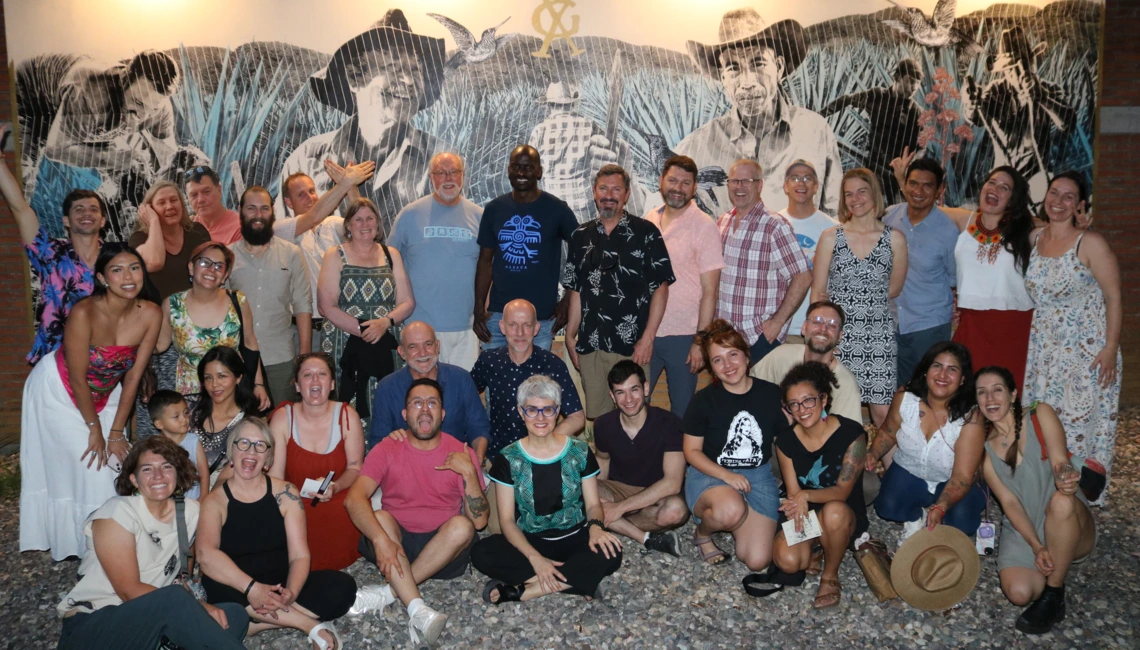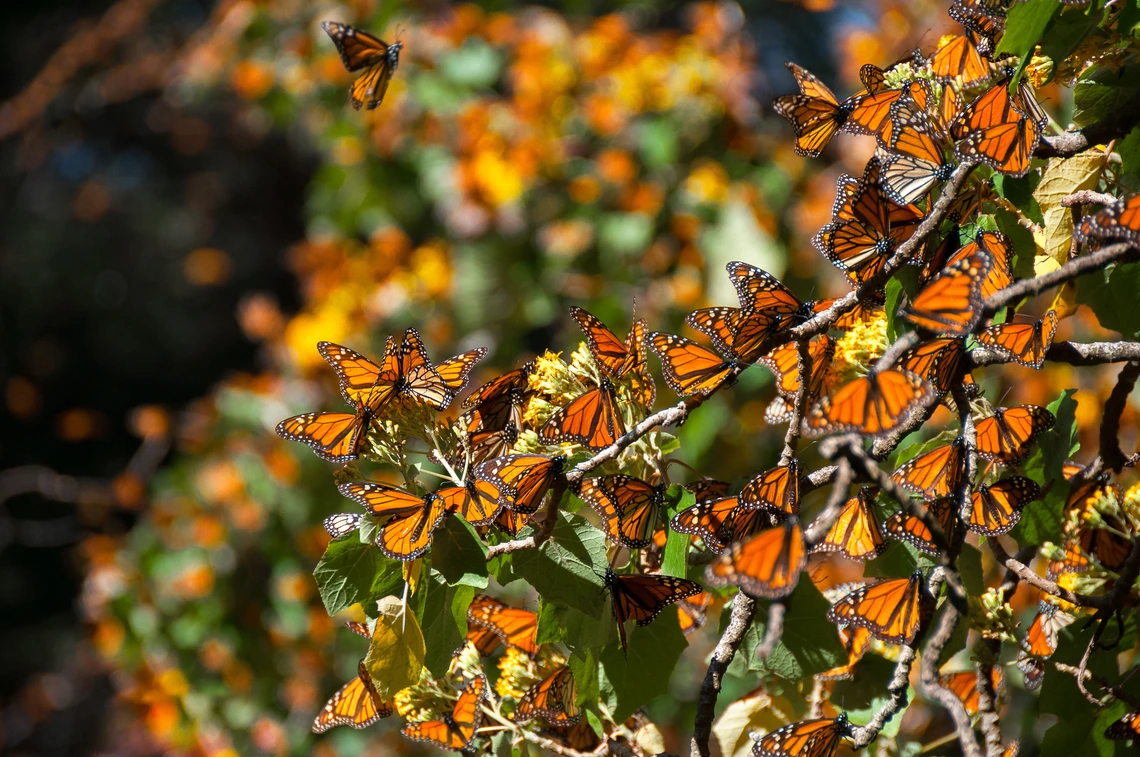Migratory species cross borders. Conservation strategies should, too.
EMIGRA is documenting management strategies for migratory species across North America.

The EMIGRA team, including the Conservation & Cultural Research Fellows during a visit to a producer of bat-friendly mezcal in Oaxaca, Mexico. Mezcal production depends on pollination of agaves by bats in the genus Leptonycteris, which includes the lesser long-nosed bat. These nectar-feeding bats follow the agave blooms as they migrate across latitudes between Mexico and southern Arizona.
Over the last 90 years, almost 6 million acres of wildlife habitat throughout the United States have been protected thanks to an unconventional benefactor: the Duck Stamp.
Duck Stamps, also known as Migratory Bird Hunting and Conservation Stamps, are postage stamps purchased by duck hunters and collectors alike. Their sales have generated $800 million to help fund more than 300 national wildlife refuges, including invaluable wetlands that help protect both natural and human resources
The Duck Stamp program has been called “one of the most successful conservation programs ever initiated.” It’s also one example of the conservation solutions that University of Arizona researchers are studying through the EMIGRA project, funded by the National Science Foundation.
Led by Jonathan Derbridge, research scientist at the U of A’s School of Natural Resources and the Environment (SNRE), and Laura López-Hoffman, professor in SNRE and a research professor at the Udall Center for Studies in Public Policy, an interdisciplinary team of researchers across North America are working to better understand how migratory species are managed within and across international borders.

“Migratory species have been shown to be at the highest risks of extinction,” López-Hoffman said. “Because migratory species go such long distances and need a variety of habitats, they need people to coordinate and collaborate in different countries, so they are some of the most difficult species to protect.”
At the heart of EMIGRA’s work is the “telecoupled” nature of migratory species. These birds, bats, and butterflies link human and natural systems across thousands of miles, and environmental change in one area could have large consequences on the benefits these species provide in another.
With that in mind, EMIGRA, the Spanish acronym for “Equitable Governance of Migratory Species and their Habitats,” has been building an unprecedented database of more than 900 known North American migratory species.

“Our goal was to understand the spectrum of governance that exists today for those species, and at the end have some recommendations or actual principles for designing new ways of doing conservation,” Derbridge said. “So far, we’ve found that a little over a third of migratory species have management plans, nearly all of them are for birds and fishes.”
As the EMIGRA team continues to collect detailed data about these species and management strategies, Derbridge says they are looking to identify trends like which species tend to be protected, how the protection of different species is justified, and potential gaps in these protections.
“The Sonoran Desert is one of these jewels that’s an incredibly biodiverse place with many species migrating between the borders between countries,” Derbridge said. “Lines on the map have no meaning whatsoever to any wild animal.”
Of particular interest to the EMIGRA team is migratory insects, which have largely been overlooked in existing management strategies, López-Hoffman said. In fact, scientists don’t have a complete count of how many migratory insect species exist in North America; they are a “black box,” and coinciding with the global insect diversity loss crisis, the lack of insect conservation plans could create a particularly alarming situation, she said.
“If you look at patterns of biodiversity, the greatest biodiversity is in insects, and we know insects play critically important roles in almost every terrestrial ecosystem,” López-Hoffman said. “However, if we look at migratory species in terms of international protections, the majority of migratory species that are protected are birds and fish.”

Monarch butterflies at a Biosphere Reserve in Michoacan, Mexico.
One insect the team is studying is the monarch butterfly. Monarchs travel from their summer home in southeast Canada and the northeast U.S. to their winter home in central Mexico, confronting different challenges at each stage of their journey.
For example, if Mexico doesn’t protect the forests the monarchs use to hibernate, they won’t have any winter habitat. However, intensive agricultural practices in the U.S. threaten the health and habitat of Monarchs during the summer. Both countries, López-Hoffman said, have a responsibility to protect monarchs for the benefit of all.
“Because migratory species go such long distances and need a variety of habitats, they need people to coordinate and collaborate in different countries, so they are some of the most difficult species to protect," López-Hoffman said.
Southern Arizona is a unique embodiment of biodiversity and migration. Its location south of the Rocky Mountains and north of Mexico’s Neotropical region creates a confluence of climates that contribute to it being the most biodiverse desert on Earth.
“The Sonoran Desert is one of these jewels that’s an incredibly biodiverse place with many species migrating between the borders between countries,” Derbridge said. “Lines on the map have no meaning whatsoever to any wild animal.”
The interconnectedness of natural and human systems is central to the team’s hypothesis that telecoupled governance – or governance that recognizes and crafts approaches around these connections – leads to more sustainable outcomes.
“We're trying to demonstrate that species are a link for us sharing the environment across borders with other people, and part of that sharing is fairness,” López-Hoffman said. “I think that there's a hunch on the team that the more equitable the system is, the better it operates.”

The Conservation & Cultural Research Fellows during EMIGRA's team meeting in Oaxaca, Mexico, planning their approach to data collection across 10 geographic regions of North America.
For Derbridge, the first step in evolving the field of migratory species conservation forward is recognizing all that communities are already doing to help support wildlife. To help with that goal, EMIGRA launched a “Conservation & Cultural Research Fellows” program that embeds researchers across 10 regions throughout Mexico, the U.S., and Canada.
These local research fellows are already familiar with their region’s context and better understand how the relationship between local culture and the environment is expressed. Derbridge said the fellows have already documented some "completely unexpected and fascinating results on how people in these parts of Mexico, the U.S. and Canada are interacting with these species."
“People across all parts of the land those animals occupy on their migrations are contributing one way or another to conservation, but in many cases that has never been accounted for,” he said. “If we want to do sustainable conservation, we need to take account of that and include all stakeholders.”
Learn more about EMIGRA at their website, emigra.arizona.edu.
